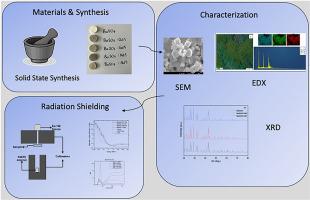Structural, morphological and gamma radiation shielding characteristics of Gd and Nd doped BaSO4
IF 2.8
3区 物理与天体物理
Q3 CHEMISTRY, PHYSICAL
引用次数: 0
Abstract
In this study, gamma attenuation properties of Gd and Nd doped barium sulfate (BaSO4) were investigated using a gamma spectrometry system with narrow beam geometry. Materials were synthesized by solid-state synthesis method, and characterized to evaluate their structural, morphological, and radiation shielding properties. The effect of the doping rate was also studied. Linear and mass attenuation coefficients were determined, and from these values, atomic and electronic cross sections, effective atomic number, and electron density, half value layer (HVL), tenth value layer (TVL), and mean free path (MFP) values were also calculated. The results were compared with XCOM values. It was found that doping Gd and Nd increased the attenuation coefficients in the low-energy region, but their effect was limited at higher photon energies. The same trend is also observed for other calculated parameters such as HVL, TVL, and MFP. The bare BaSO4 samples, as well as samples doped with Gd and Nd, are found to have high attenuation properties, showing potential in shielding and other dosimetric utilization. Radiation shielding capability was investigated using exposure buildup factor (EBF) calculations via the EpiXS software. The results indicated significantly high EBF values at low photon energies (40–100 keV) and in deep penetration scenarios (>10 mfp). In addition to the radiation attenuation properties, the structural and morphological properties of the samples were also determined by SEM, EDX and XRD methods. The SEM analysis revealed the coexistence of submicron spherical particles and particles with sharp edges, which resulted from the synthesis temperature and the mechanical crushing effect of an agate mortar. EDX analysis confirmed the successful incorporation of dopant elements into the BaSO4 crystal structure.

Gd和Nd掺杂BaSO4的结构、形态和γ辐射屏蔽特性
在这项研究中,使用窄光束几何形状的伽马能谱系统研究了Gd和Nd掺杂硫酸钡(BaSO4)的伽马衰减特性。采用固态合成方法合成了材料,并对其结构、形态和辐射屏蔽性能进行了表征。同时研究了掺杂率的影响。测定线性衰减系数和质量衰减系数,并根据这些值计算原子和电子截面、有效原子序数、电子密度、半值层(HVL)、第十值层(TVL)和平均自由程(MFP)值。结果与XCOM值进行了比较。结果表明,Gd和Nd的掺杂增加了低能区的衰减系数,但在高能量区域的作用有限。对于其他计算参数,如HVL、TVL和MFP,也观察到相同的趋势。发现裸BaSO4样品以及掺杂Gd和Nd的样品具有高衰减特性,在屏蔽和其他剂量学应用中具有潜力。通过EpiXS软件计算暴露累积因子(EBF)来研究辐射屏蔽能力。结果表明,在低光子能量(40-100 keV)和深穿透场景(>10 mfp)下,EBF值显著高。除了辐射衰减性能外,还通过SEM、EDX和XRD等方法测定了样品的结构和形态特性。扫描电镜分析表明,合成温度和玛瑙砂浆的机械破碎作用导致了亚微米球形颗粒和边缘锋利颗粒的共存。EDX分析证实了在BaSO4晶体结构中成功加入了掺杂元素。
本文章由计算机程序翻译,如有差异,请以英文原文为准。
求助全文
约1分钟内获得全文
求助全文
来源期刊

Radiation Physics and Chemistry
化学-核科学技术
CiteScore
5.60
自引率
17.20%
发文量
574
审稿时长
12 weeks
期刊介绍:
Radiation Physics and Chemistry is a multidisciplinary journal that provides a medium for publication of substantial and original papers, reviews, and short communications which focus on research and developments involving ionizing radiation in radiation physics, radiation chemistry and radiation processing.
The journal aims to publish papers with significance to an international audience, containing substantial novelty and scientific impact. The Editors reserve the rights to reject, with or without external review, papers that do not meet these criteria. This could include papers that are very similar to previous publications, only with changed target substrates, employed materials, analyzed sites and experimental methods, report results without presenting new insights and/or hypothesis testing, or do not focus on the radiation effects.
 求助内容:
求助内容: 应助结果提醒方式:
应助结果提醒方式:


